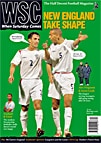 Ian Plenderleith enjoys mascots as much as the next man – as long as the next man isn't intent on practising his best costume-related moves in front of the mirror while concentrating on "the three Es"
Ian Plenderleith enjoys mascots as much as the next man – as long as the next man isn't intent on practising his best costume-related moves in front of the mirror while concentrating on "the three Es"
There are a few cardinal rules for club mascots. They must be smiling, at all times. Their names must be alliterated or rhyming, like Donny the Dog or Scunny Bunny. And, in theory, they should have some sort of historical connection to the team they represent. A website that shows several dozen English club mascots on one page has, however, revealed the scandalous truth that most clubs are breaking at least one, if not all three, of these basic good-luck guidelines.
Sports Mascots does what it says in the url, and that’s just about enough – a picture of the mythical creature, its name and its club. It’s just as well we’re told the latter, because you’d be hard pushed to work it out for yourself in many cases. Why would Portsmouth be represented by Frogmore the Frog? Was there once a legendary sailor based in the southern port city called Captain Frogmore? What are the respective traditions of elephants in Coventry and hippos in Stoke? The site lets you draw your own conclusions.
More alarming is the number of Premier and Football League lions without a proper name starting with an L. There’s Aston Villa’s Hercules, Stamford Lion at Chelsea, Roary Lion at Middlesbrough, Blackburn and Macclesfield, Zampa the Lion at Millwall, and Kingsley the Lion at Reading. Only Lofty at Bolton and Lennie at Shrewsbury get it right. Come on you people, make an effort here. Just go to Baby Names World and see if you can’t come up with a Langston or a Lambert, or Lazarus or Ladislav. Even Brian the Lion (already taken by Bayer Leverkusen if you look at the European page) would work. But Kingsley the Lion? Is someone in the Madejski marketing department deliberately looking for the sack?
League One is particularly good for illogical mascots. Oldham, inexplicably allying themselves with Sheffield Wednesday, have Chaddy the Owl (feeling threatened by this, Wednesday have gone for a set of three owl mascots, Bazz, Ollie and Ozzie, to assert their night-bird superiority, though an interpretation of the day “Wednesday” in mascot form might also prove interesting. Midweek Mickey, anyone?). Northampton boast Clarence the Dragon (“Puff” was scrapped at the planning stage), as gormless and unfirelike a creature as you’ve ever seen, while Theo the Wyvern (Orient) and Tommy Trublew (Gillingham) defy all explanation, being named as they are after an obscure kind of dragon and a… trublew? I get the “true blue” part, but why would a “trublew” be a horse with a mohican?
Best of all, though, are the mascots that look as miserable as their teams. Billy Brewer at Burton Albion looks like he was scraped off the pub floor after a lunchtime session; Shaggy the Sheep at Merthyr Tydfil is clearly on his way to the slaughterhouse; and “Samson”, a tall and bearded, morose but indeterminate creature at Sunderland, looks like he’s ready to face the firing squad. Time for Roy Keane to have a word about giving it 110 per cent. All in all, one of the most entertaining single football pages on the internet.
“The most important thing to remember when you’re first starting out as a mascot is that your human identity will be set aside,” notes a US advice website, MascotNet! Here you can find all kinds of tips on maintaining your costume (“try an upholstery or rug-cleaner to clean the fur-covered areas”), safety (“do not wear mascot heads while driving a vehicle”) and health (“costumes are breeding grounds for viruses”).
It seems that the role of mascot is taken very seriously in North America. When you apply for a mascot’s job you should “focus especially on creating realistic goals and objectives for your team’s mascot program”. You can create your own video, “even if it’s you in a rented costume, dancing in your living room”, and put together a routine “showing diversity in flavour, speed, emotions”.
The “acting” section gives fundamental guidance on the three Es: Entrance (stomp on the ground, wave your arms), Exaggeration (pick your feet up off the ground and “use your whole body”) and Emotion, where aspiring mascots are advised to practise a number of sentiments, “happy, sad, angry, scared, excited, in front of a mirror with your head on”.
Once you’ve got the coveted job, kids pose the biggest threat, in any number of ways. If you get “clobbered” by a kid, don’t retaliate with an eye-for-an-eye, the site advises. Keep cool. And if you decide to hug or pick up a child, “don’t let your hand stray to any part of a child (or anyone else) that could be interpreted as unacceptable”. Mascots have apparently lost their jobs for lesser sins.
When it comes to actually bringing good luck to your team, the key to victory is withheld. And until Bartley the Bluebird or Bloomfield the Bear publishes a tell-all memoir, or a warts-and-all blog, that’s the way it’s going to stay. I imagine it’s something like the magicians’ code of secrecy. No matter what happens, be you lion, stag, owl or trublew, you are bound by mascots’ honour to keep it inside the costume.
From WSC 238 December 2006. What was happening this month